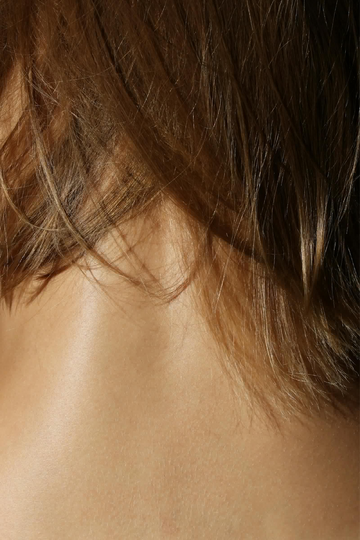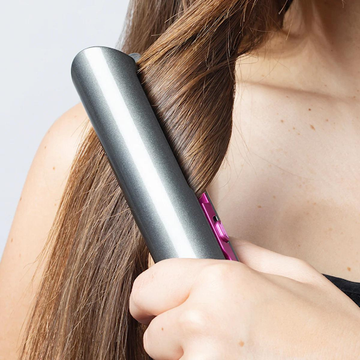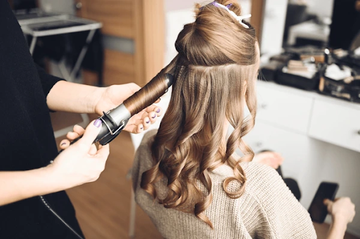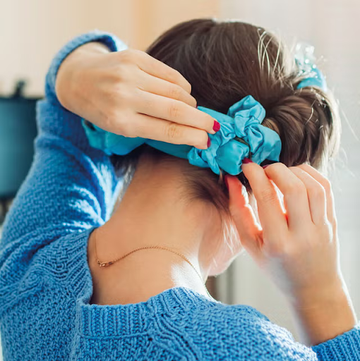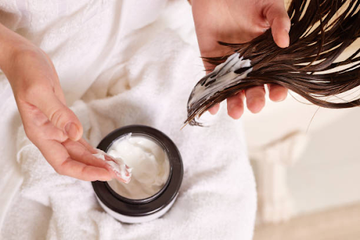Blog Summary: Hair often won’t grow past a certain length because of factors like genetics, breakage, and overall hair health.
- Genetics determines the length of your natural hair growth cycle.
- Breakage from heat, chemicals, or rough handling can cancel out new growth.
- Poor scalp health and buildup weaken follicles and slow growth.
- Hormonal imbalances, aging, or nutrient deficiencies can stunt progress.
- Gentle care, scalp support, and proper nutrition help retain length.
There’s a science behind slow hair growth, and it’s not just bad luck
Does your hair tend to stop growing at a certain length? You’re not alone.
There’s nothing more humbling than realizing your hair has stopped growing and been the same length for months. Maybe even years. You swear you’re doing everything right—deep conditioners, trims, vitamins, the works—and yet your ends just keep waving the white flag.
If you’ve ever thought, “Why won’t my hair grow past a certain length?” believe us when we tell you that you’re not making it up. Hair plateaus are real—and they happen to way more people than you might think.
The thing is, hair growth isn’t just about what you put on your strands. A million tiny factors are happening behind the scenes—from genetics and hormones to breakage you can’t even see until it’s too late. And while it’s easy to blame your shampoo or your diet, the truth is, hair growth (and hair loss) are both way more complicated than just switching products.
The good news? Once you understand the real reasons your hair might be stuck, you can start working with your hair’s natural growth cycle instead of fighting against it. That’s where the magic happens.
Ahead, we break down the science behind stubborn hair length—and give you the real, no-BS advice you need to help your hair grow healthier, stronger, and maybe even longer than you thought possible.
The biggest myths about hair growth
Before we get into the real reasons your hair might feel stuck, let’s clear something up. There’s a lot of bad advice floating around when it comes to hair growth. Some of it sounds convincing. Some of it has been passed down like family secrets. And some of it is just plain wrong.
If you’ve ever been told your hair would grow faster if you trimmed it every full moon or that brushing it 100 times a day would “stimulate” growth, sorry, but you’ve been fed a myth, babe.
Here’s a reality check on a few of the biggest hair growth misconceptions.
– Myth 1: Regular trims make your hair grow faster.
Trims are super important for healthy ends, but they don’t affect your hair’s actual growth rate. Hair grows from the scalp, not the ends. Regular trims just prevent breakage and split ends from traveling higher up the shaft, making it look like your hair is growing longer, healthier, and stronger.
– Myth 2: More brushing = more growth.
Old-school advice said that brushing stimulated your scalp and boosted growth. In reality? Aggressive or excessive brushing can actually cause breakage, split ends, and even hair thinning over time. Gentle brushing to detangle is great—playing tug-of-war with your strands is not.
– Myth 3: Expensive products can "force" your hair to grow.
There’s no magic shampoo or serum that will flip a switch and make your hair grow faster overnight. Good products can support a healthy scalp and stronger strands, but growth speed comes down to things like genetics, diet, hormones, and overall hair care habits—not just your product lineup.
– Myth 4: If your hair isn’t growing, it’s because you’re doing something wrong.
Not true. Does your hair stop growing at a certain length? Sometimes, it’s not you—it’s biology. Your hair could be stuck at a certain length because of your natural growth cycle, not because you missed a deep conditioning session last week.
The TRUTH? It’s time to stop blaming yourself (or your brush). Real hair growth is about working smarter, not harder—and it starts with knowing what’s going on beneath the surface.
Why does my hair not grow past a certain length? (the real reasons)
Now that we’ve cleared up the biggest myths, let’s talk about what happens when your hair feels like it’s frozen in time.
Spoiler: it’s not just one thing. Most of the time, it’s a mix of internal and external factors quietly working against your growth goals.
Here’s the real tea on what could be slowing you down.
Genetics
Before you blame your hair products—or yourself—know this: genetics plays a huge role in your hair’s maximum potential length.
Everyone’s hair grows in cycles, and how long your "growth phase" (aka anagen phase) lasts is coded into your DNA. For some of us, hair keeps growing for up to 7 years. For others, the cycle taps out after just a couple of years, meaning our hair naturally maxes out at a certain point, no matter how many deep conditioning treatments we try.
If it feels like your hair is loyal to a certain length, your genes might be setting the rules.
One of the biggest mind games hair plays on us? Breakage can look exactly like a growth plateau.
If your ends are constantly snapping off due to heat styling, coloring, rough brushing, or even harsh towel drying, your hair is technically growing at the root—you’re just losing length just as fast (or faster) than you’re gaining it.
That’s why trimming damaged ends and protecting your hair from mechanical and heat stress is non-negotiable if you’re serious about growing longer hair.
Poor scalp health
Healthy hair starts with a healthy scalp—and if your scalp isn’t thriving, your hair won’t be, either.
Issues like buildup (hello, dry shampoo overload), clogged follicles, or even chronic dryness can all suffocate your hair at the root, making it weaker, thinner, and more prone to breakage over time.
Think of your scalp like soil: if it’s dry, blocked, or unhealthy, nothing can grow properly. Giving your scalp regular TLC—like gentle exfoliation, hydration, and scalp massages—can make a massive difference in creating a better environment for growth.
Hormonal imbalances
Sometimes, the reason your hair isn’t moving past a certain length has nothing to do with your products or your styling habits—it’s what’s happening inside your body.
Hormonal shifts (like thyroid issues, pregnancy, postpartum changes, or PCOS) can seriously impact your hair’s growth cycle, sometimes causing shedding, thinning, or slower-than-usual growth.
If you’ve noticed other symptoms alongside stagnant hair growth (like fatigue, skin changes, or irregular cycles), it might be worth chatting with a healthcare provider to rule out any underlying issues.
Aging and hair miniaturization
We hate to break it to you, but aging affects more than just your skincare routine. As we get older, hair follicles can start to shrink (a process called miniaturization), leading to thinner strands and shorter hair growth cycles.
This doesn’t mean you’re doomed to dull, lifeless hair, but it does mean you might need to tweak your routine to focus more on strengthening and thickening your strands, not just growing them longer.
Overprocessing and styling habits
Heat tools, chemical treatments, tight hairstyles, and rough detangling don’t just cause breakage—they can also damage your hair at the structural level, making it weaker and less able to reach longer lengths.
High-tension styles (like snatched ponytails and tight braids) can cause traction alopecia over time, while frequent bleaching or chemical straightening can permanently weaken your hair shaft.
If your goal is length, think "low-stress styling" wherever you can: loose buns, heat-free styles, protective hairstyles, and being super gentle with brushing and detangling.
Nutrient deficiencies
Your hair is one of the first parts of your body to suffer when you’re missing key nutrients. If your diet is low in protein, iron, zinc, biotin, or vitamins A, C, D, and E, your strands might not have the building blocks they need to grow properly.
Adding more nutrient-dense foods (like leafy greens, lean proteins, nuts, seeds, and healthy fats) can be a game-changer. And if you’re not sure you’re getting enough? It’s always worth checking in with your doc before reaching for supplements.
How to help your hair grow healthier and stronger
Now that we know what’s getting in the way, let’s get into the good stuff—what you can actually do to encourage healthier, stronger hair that can reach its full potential.
Be gentle (really gentle)
Think of your hair as delicate silk. Aggressive brushing, tight hairstyles, rough towel drying, and even sleeping on cotton pillowcases can all cause micro-damage that adds up over time. Swap in a satin or silk pillowcase, use a wide-toothed comb on wet hair, and treat your strands with serious TLC, especially when they're damp and vulnerable.
Focus on scalp care
A healthy scalp is non-negotiable if you want real hair growth. Regular scalp massages (even just a few minutes a day) can help boost blood circulation and deliver more nutrients to your follicles. Using a gentle exfoliating scalp scrub once a week and choosing lightweight, buildup-free shampoos can also make a big difference. Remember: clean, balanced scalp = happy, thriving hair.
Dial back the heat
We get it—some days, you just need your curling iron or blow dryer. But every time you heat style, you're chipping away at your hair’s strength. Lower the temperature on your tools, always use a heat protectant, and embrace air-drying whenever you can. Small changes now add up to longer, stronger hair later.
Nourish from the inside out
No amount of hair masks you use can fix what’s missing on the inside. Eating a diet rich in iron, biotin, protein, zinc, and vitamins A, C, D, and E can give your hair the building blocks it needs to grow. Think leafy greens, salmon, nuts, seeds, berries, and eggs. (Bonus: your skin and nails will thank you, too.)
Protect your ends
The ends of your hair are the oldest, most fragile part—meaning they need extra protection if you want to retain length. Hydrating serums, leave-in conditioners, and lightweight oils can help seal in moisture and prevent breakage. A little extra love at the ends goes a long way when you’re trying to grow your hair longer.
Give it time (and grace)
Even with the best routine in the world, hair growth takes time. On average, hair grows about half an inch per month. That means it could take a full year to see a meaningful difference. Stay consistent, stay patient, and celebrate the tiny wins (hello, healthier baby hairs!) along the way.
Final thoughts? You (and your hair) are doing better than you think
If your hair feels like it’s stuck, you’re not alone—and you’re definitely not doing anything wrong. Growth plateaus happen to the best of us, and they’re way more common (and fixable) than you’ve been led to believe.
The truth is, your hair might be growing just fine—you might just need a few tweaks to help it thrive and reach its full potential. A little more patience, a little LESS heat, a LOT more scalp care. It’s not about chasing overnight miracles. It’s about playing the long game and trusting the process.
If you’re feeling frustrated with slow progress, remember, stronger, healthier hair is *always* worth the wait.
Hair Growth FAQs:
Why won’t my hair grow past a certain length?
Often it’s a mix of genetics, breakage, and lifestyle factors. Even if your hair is growing at the root, damage at the ends can cancel out progress.
Does your hair stop growing at a certain length?
Not exactly—hair grows in cycles, but some people’s growth phase is naturally shorter, meaning their hair maxes out at a certain length.
Why won’t my hair grow at all?
If your hair stopped growing, it could be due to scalp health, hormonal changes, nutrient deficiencies, or too much breakage.
Can you make your hair grow past its limit?
While you can’t change genetics, you can protect your strands, support scalp health, and improve retention so your hair grows as long and strong as possible.

